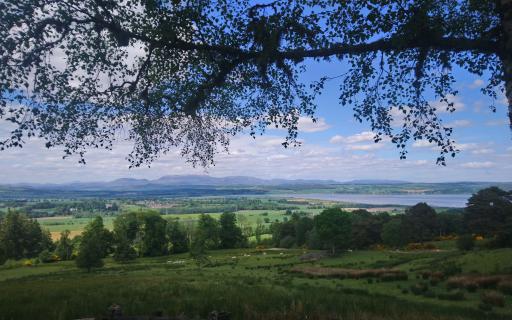
Inverness Castle Poem
For me, the Spirit of the Highlands is in its people and its stories, and how the landscape and our history has shaped these things.
In writing a poem about Inverness Castle for the Spirit of the Highlands project I wanted to create something that was historically accurate, but which also worked as a piece of writing on its own terms. It was a way of capturing some of the history of the castle, but also some of the meaning: how it appears to both visitors and locals.
To do this, I thought about the form and content. I was reading different poems written by travellers, or by people engaging with the idea of ‘the north’, and the form is based loosely on what I have read. I wanted a conversational tone, where the speaker in the poem gave the sort of fleeting yet memorable impressions a traveller, or a student of history, might remember after a visit to the castle; the impression of these years of history piling and tumbling on top of each other – although, they are actually all placed within a structure. The castle was architecturally planned, and I wanted the poem to reflect that sense of form – designed to fit a logical sequence, yet also created with some sense of romantic informalism.
GETTING STARTED
To research the content of the poem I looked at many books and articles about the history of the castle and Inverness, the architecture and design of the castle, and viewed many images, both of the modern castle, and drawings and older images of previous castle or the site itself. I see the castle every day from my street, and walk past it frequently as I live in the centre of Inverness, and I have followed the transformation of the castle for the Spirit of the Highlands project since the beginning.
My starting point for the writing was the statue of Flora Macdonald, endlessly watching down the Great Glen. I have always loved the statue, and felt a great respect for Flora, a woman of honour and principle who had a fascinating life.
The verses of the poem look at different moments from the castle’s history. Inverness has a long historical association with Macbeth – although some descriptions of where his castle was are of dubious historical accuracy. The Governors of Inverness castle managed the site through the medieval period, particularly the Mackintosh, the clan most associated with this area. Inverness was of central importance during the Wars of Independence, and Andrew de Moray is another local hero. The castle then passed into the care of the Gordons, though their association with the castle and Mary, Queen of Scots was not a happy one. The castle fell into ruins, though was briefly shored up by government troops and renamed ‘Fort George’ after the 1715 Jacobite uprising. Bonnie Prince Charlie took the castle back, and had it completely destroyed as it became obvious his cause was failing. The French soldier tasked to blow up the castle made a serious mistake with the explosives, and he and his dog were horribly killed in the resulting explosion. The castle site was then completely cleared and left empty until acts in 1819 and 1839 gave financing to build prisons and sheriff courts. The new castle was planned as a centrepiece for a town moving into the Victorian era when all things Highland were celebrated. It was in constant use as a court, and also for things such as the police department and offices, until the new transformation into a tourism and cultural centre began.
THE POEMS
I have written two poems, along with completing supporting material such as audio, video and writer’s statements.
Over the last wee while, I have been combining my interest in writing non-fiction history and biography with my interest in poetry. This piece of writing is based on extensive research into the history of Inverness Castle, distilling it all into about four minutes of poetry.
Performed and filmed on location at the castle itself, next to the statue of Flora MacDonald.
Inverness Castle
a poem by Jennifer Morag Henderson
And Flora said nothing, for now, but watched endlessly down the glen
for her past and future king; the River Ness a blue thread weaving through the heart
of town, and the red sandstone castle sitting,
a hill-fort above the stream –
The pretty daughters walking through the ruins of melancholy
appearance, an illicit free-stone quarry, the martlet birds
nesting, hidden, once again. A clearance
where kings used to be.
and thought this chequered history –
this approach to Inverness, by sea and the coastal route
to land, the Via Regis King’s Route
the memory of Macbeth –
The washerwomen on the drying green below the old castle site –
below where Flora stands today – soon only the cellars remain.
But then, there is a new town.
A new court. A new jail.
this pleasant seat in delicate air, the birds nesting there,
breeding and haunting in wild Shakespearian imagery
through the gatehouse to the wooden stockade
of a medieval secular authority.
An age of change and progress, a site for visits of ceremonial
reflecting the standing of the county, the innovation
of architecture, the reclaiming
of prestige, of Scottish style.
The hereditary Governors of Inverness Castle, the MacDuffs,
the Mackintosh: the centuries of clans. And Inverness centred, early and staunch
in the Scottish Wars of Independence:
de Moray, the great man.
With a generous approach for horse and coaches, the castle
turns its back upon the town, reorients itself as a romantic
ashlar assemblage of towers
a splendid courtroom
Until Gordons lavished money on their residence, Italian artists in the gallery,
the hall of stone and lime upon the vaults 100 feet long,
and Mary, Queen of Scots came knocking at the doors,
to be refused entry.
a robing-room for Judges, jury-rooms and witness-rooms
and cells, under machicolated parapets, roundheaded windows,
an imperial stair rising
in this rallying place.
Mary’s squadron of ships anchored in the harbour as the gallants
gathered and the clans paid homage and she shopped for tartan –
but the hanged men stayed on the battlements
until she left.
And Flora, in bronze, gazing down the Great Glen
watching over the changes, the prisoners of the Crofters’ War,
Mairi Mhor singing in the jail, the slow deterioration
of the soft sandstone
The occupation by the clans, the doors, gates and windows broken up
the plenishing spoiled, the rich library gone
the tower destroyed and the castle
falling into ruins.
the installation of the cannon from the Crimea
the flagstaff linked to Sebastopol, the gun from Loos
the police vans, the constabulary
the fire department, the family court
The troops stationed there. Occupied by government soldiers,
the Jacobites’ brief retaking in the ’15, yet overtaken once again:
Fort George. Hanoverian. The roof
flat and leaded. Thick walls.
this distillation of our history, the travellers and what they see
and what that means to them, and what a tourist does
and the essence that they hear
and where we are now
Bonnie Prince Charlie left the castle and his cause in tatters:
blown up by explosive, his French sergeant hurled to his death
across the river, the story of the little dog caught
in the terrific detonation.
with an image of our home, and a writer,
a national character and more old stories
and a castle, and a woman
watching, always watching down the glen.
The Travels of James Fraser
My poem about James Fraser was inspired by one of the pieces submitted to the ‘100 stories’ initiative, and by my own historical research into the real James Fraser and his life and writing.
James Fraser was a minister, writer, historian and traveller from the 1600s, who wrote about the history of the clan Fraser, and its place in Scotland and in Europe.
Master James Fraser’s History of the Ward Law
a poem by Jennifer Morag Henderson
This small place is the centre of the world.
I stand in the clipped green grass of the watch hill
and see the roads travel down before me
out to Europe, and back into the past.
the seat of the clan is the centre of Europe
and I gather around the family story sketches
of Scotland, England and every Continental state.
The harangues of our northern heroes raise
the flames of activity here in the Highlands
I stepped out to view the universe
all senses connected, entangling
with cities alive with activity
London – Dieppe – Marseilles
swathes of countryside
Italy – Bavaria – Bohemia
providence was my convoy in all my travels and voyages.
history is a telescope to the past, and
a mirror of the present. It changes lives.
I wish my writing to be lively enough in so small a circle
as to content the curious in after ages.
When I returned unexpectedly one Sabbath morning
the bells of the church rang out a welcome.
I was the one who left, and the one who came back, returned to share:
now: let my words take you there:
This is the spirit of my Highlands, this spirit of open
enquiry, this telling of tales
here under the crown and strawberry flowers of the Fraser crest
it is a weighty work: a matter of moment
without travelling our open history, we move blind
through the landscape. I tell a synchronism
of events of clan and continent –
be my fellow traveller –
I tell
many histories in one.
DISCOVER MORE FROM JENNIFER MORAG HENDERSON HERE
www.jennifermoraghenderson.com
